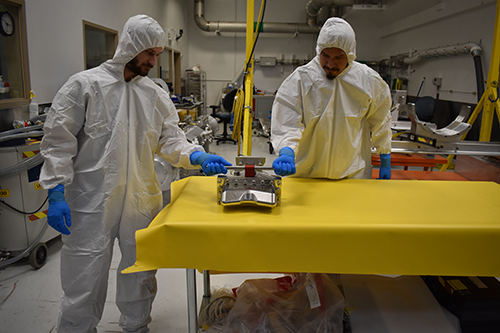Ignition experiment advances stockpile stewardship mission
 (Download Image)
(Download Image)
Members of the LLNL Weapons & Complex Integration directorate work on the fielding hardware commissioned for use in weapons survivability experiments. The steel case protects against the destructive force from significant amounts of X-rays and debris wind generated by megajoule-class inertial confinement fusion experiments. Photo by Garry McLeod/LLNL.
Third in a series of articles describing the elements of Lawrence Livermore National Laboratory's fusion breakthrough.
When scientists at Lawrence Livermore National Laboratory (LLNL) achieved fusion ignition at the National Ignition Facility (NIF) on Dec. 5, 2022 — an extraordinary scientific breakthrough that was decades in the making — the primary mission and driving goal behind the experiment that day was stockpile stewardship science.
LLNL is one of two National Nuclear Security Administration (NNSA) laboratories that certify the safety, security and effectiveness of the nuclear explosives packages in the U.S. nuclear stockpile. As part of that work, the Weapon Survivability program develops the innovative computational capabilities and experimental platforms to design and certify the nation’s nuclear deterrent to survive and still perform as expected in a variety of extreme environments, including hostile radiation effects or a nearby nuclear detonation.
“A big part of our science-based Stockpile Stewardship Program is making sure we have experimental access to methods for weapons testing that allow us to test our calculations, check our simulations, develop our intuition, and test the understanding we have from the nuclear tests we did during the underground testing era,” said Mark Herrmann, program director for Weapon Physics and Design at LLNL.
Igniting inertial confinement fusion capsules at NIF simulates aspects of the conditions that exist in an exploding nuclear weapon — producing intense radiation and providing a unique ability for LLNL to test in a pulsed thermonuclear neutron environment.
Commissioning new fielding hardware
“The inertial confinement fusion (ICF) program has been working for many years to demonstrate higher megajoule yields and ultimately reach ignition. But that's not the end in and of itself,” said Laura Berzak Hopkins, associate program director for Integrated Weapon Science. “The goal of the December shot was really two-fold. Not only did we achieve ignition, which is really a remarkable achievement, but we also commissioned a new set of fielding hardware engineered to survive megajoule environments.”
National Ignition Facility operators examine the CryoXNBS hardware that was fielded on the December 2022 fusion ignition shot. The experiment demonstrated that the snout could survive the extreme environment of megajoule neutron yields and perform according to expectations, qualifying the snout for use in future experiments. Photo by Charles Yeamans.
Designed and built by the NIF Materials and Radiation Effects group, the u-shaped hardware, called the cryogenic-compatible X-ray, neutron, and blast snout (CryoXNBS), was inserted into the NIF main target chamber and situated approximately 10 to 12 centimeters from the target, allowing researchers to expose various weapon-relevant samples, such as uranium or other materials, as well as electronics, to the highest possible thermonuclear fusion neutron fluences available.
To protect the material contained inside, the snout utilizes a 22-kilogram (or 50-pound) steel case to protect against the destructive force from significant amounts of X-rays and debris wind generated by megajoule-class ICF experiments. The snout is configurable, depending on the samples, materials or diagnostics used in future experiments.
The LLNL team in December successfully qualified the CryoXNBS fielding hardware, as well as the in-situ diagnostics, demonstrating that the snout can survive the extreme environment and perform according to expectations, Berzak Hopkins said.
“From the stockpile stewardship perspective, reaching ignition is a real testament to the enabling capabilities that help us assure the safety, reliability and resilience of our nuclear arsenal,” Berzak Hopkins said. “And from an energy standpoint, this demonstration of proof-of-principle is groundbreaking. Coupling those two together, it's an inspirational moment, as it opens the door for an entirely new experimental capability that will now be enabled at NIF.”
A member of the LLNL Weapons & Complex Integration team makes adjustments to the CryoXNBS, new fielding hardware commissioned on Dec. 5, 2022. The snout enables a new experimental capability at the National Ignition Facility. Photo by Garry McLeod/LLNL.
Real-time diagnostics, post-test analysis
In developing this integrated capability, NIF engineers built diagnostics into the CryoXNBS to get real-time data from the samples situated in the snout.
In fact, one of the first indications that ignition may have been reached during the December shot came from the diagnostics connected to the survivability experiment in the fielding hardware, said Brent Blue, National Security Applications program manager at NIF.
“It takes some time for the data to get pulled off the various NIF diagnostics in the target chamber, then move through the control system, and eventually get pushed to the viewers,” Blue said, noting that the diagnostics hooked up to the experiment in the CryoXNBS gave the groundbreaking data almost instantly.
“We knew right away that something big had just happened,” he said. “We got a very good measurement, so we were very excited for the result.”
NIF operators install the Cryo X-ray Neutron Blast (XNBS) snout for the first hardware test on a megajoule-yield target on Dec. 5, 2022. The snout contains material samples and test objects to be exposed to high neutron fluence produced by the fusion target.
In addition to real-time diagnostics, the team can retract the snout to outside the target chamber after a shot, disassemble it, and complete post-test examination of samples. The team is working on developing additional types of post-test analyses that inform their understanding of how materials behave under extreme environments that are produced by a detonating nuclear weapon.
Future survivability experiments
Following the successful qualification of the snout hardware in December, future experiments are planned at NIF to assess the response of a range of NNSA and Department of Defense stockpile components and subsystems to the threat-relevant environment created by igniting ICF capsules. Researchers are also planning to steadily expand the type of materials used in survivability experiments, placing more complex samples into the snout.
“Developing this capability is critical for stockpile stewardship,” Blue said, ”but it's really a unique scientific capability that that doesn't exist anywhere else in the world to be in such close proximity to these very high neutron flux environments. We are just on the cusp of discovering what we can do with this new capability.”
___________
See Part 1: Star Power: Blazing the path to fusion ignition
See Part 2: Designing for Ignition: Precise changes yield historic results
Contact
 Paul Rhien
Paul Rhien
[email protected]
(925) 422-4206
Related Links
National Ignition FacilityStockpile Stewardship
Tags
Strategic DeterrenceFeatured Articles










